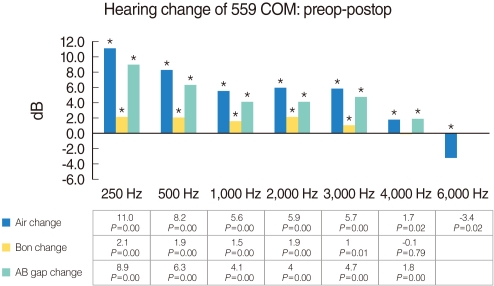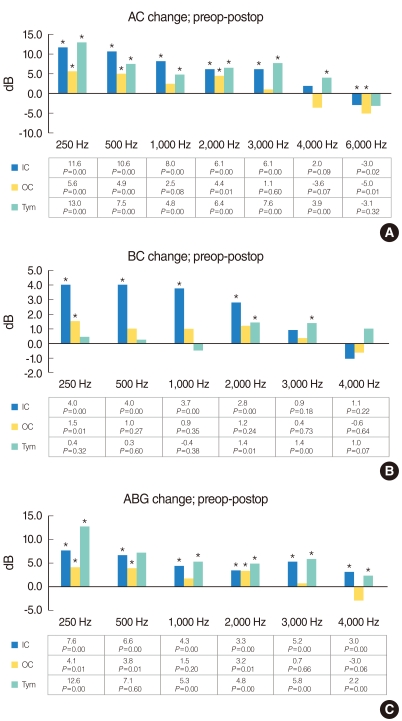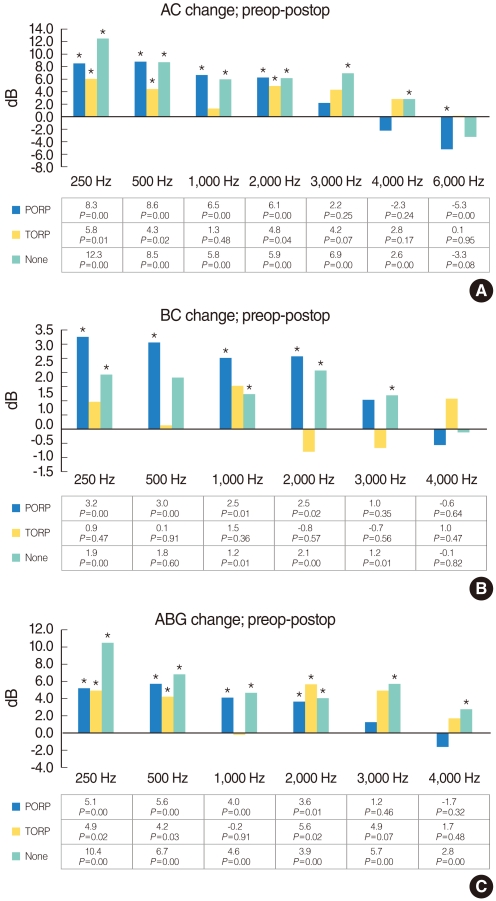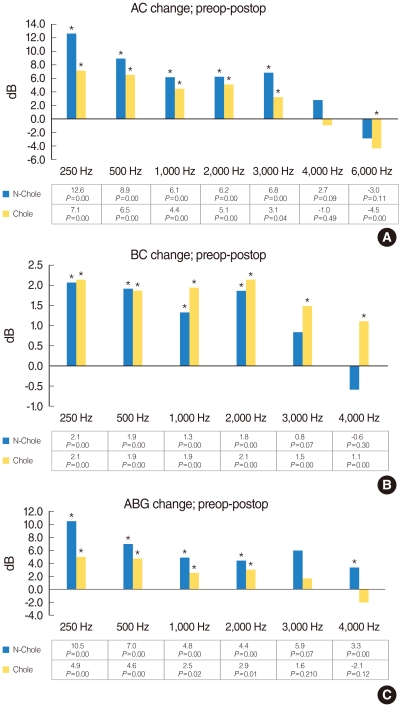Clin Exp Otorhinolaryngol.
2011 Sep;4(3):126-130.
Frequency-Specific Hearing Results After Surgery for Chronic Ear Diseases
- Affiliations
-
- 1Department of Otolaryngology Head Neck Surgery, The Catholic University of Korea School of Medicine, Uijeongbu, Korea. OTOJUN@catholic.ac.kr
Abstract
OBJECTIVES
To analyze frequency-specific hearing results after surgery for chronic ear diseases while considering pathological findings and various surgical factors.
METHODS
Patients who underwent surgical management of chronic otitis media were reviewed retrospectively (n=559). Using pure tone audiometry, air conduction (AC), bone conduction (BC), and air bone gap (ABG) change between pre- and post-operative tests were calculated for the frequencies of 250, 500, 1,000, 2,000, 3,000, 4,000 (AC and BC), and 6,000 Hz (AC). Frequency-specific results were investigated, considering various surgical factors, such as type of surgery, type of ossiculoplasty and pathological findings.
RESULTS
AC results in the intact canal wall mastoidectomy showed improvement at each frequency except 4,000, 6,000 Hz. AC results in the tympanoplasty showed improvement at each frequency except 6,000 Hz. AC and ABG results in the open cavity mastoidectomy showed improvement only at the frequencies of 250, 500, 2,000 Hz. AC and ABG improved at low and mid frequencies but not in high frequencies above 3,000 Hz when ossicular reconstruction was conducted. AC and ABG results also improved at low and mid frequencies in the cholesteatoma, and ABG results improved at all frequencies except 3,000 Hz in the non-cholesteatoma.
CONCLUSION
After chronic ear surgery, AC and ABG changes improved, primarily in the low and mid frequencies. Further evaluation and studies for post-operative hearing loss at high frequencies are recommended for rehabilitation of hearing ability after surgery.
Keyword
MeSH Terms
Figure
Reference
-
1. Jackson CG, Glasscock ME 3rd, Schwaber MK, Nissen AJ, Christiansen SG, Smith PG. Ossicular chain reconstruction: the TORP and PORP in chronic ear disease. Laryngoscope. 1983; 8. 93(8):981–988. PMID: 6877020.2. Kim HJ. A standardized database management of middle ear surgery in Korea. Acta Otolaryngol Suppl. 2007; 10. (558):54–60. PMID: 17882571.
Article3. Merchant SN, Ravicz ME, Puria S, Voss SE, Whittemore KR Jr, Peake WT, et al. Analysis of middle ear mechanics and application to diseased and reconstructed ears. Am J Otol. 1997; 3. 18(2):139–154. PMID: 9093668.4. Rosowski JJ, Merchant SN. Mechanical and acoustic analysis of middle ear reconstruction. Am J Otol. 1995; 7. 16(4):486–497. PMID: 8588650.5. Paparella MM, Brady DR, Hoel R. Sensori-neural hearing loss in chronic otitis media and mastoiditis. Trans Am Acad Ophthalmol Otolaryngol. 1970; Jan-Feb. 74(1):108–115. PMID: 5442952.6. English GM, Northern JL, Fria TJ. Chronic otitis media as a cause of sensorineural hearing loss. Arch Otolaryngol. 1973; 7. 98(1):18–22. PMID: 4713136.
Article7. El-Sayed Y. Bone conduction impairment in uncomplicated chronic suppurative otitis media. Am J Otolaryngol. 1998; May-Jun. 19(3):149–153. PMID: 9617924.8. Paparella MM, Morizono T, Le CT, Mancini F, Sipila P, Choo YB, et al. Sensorineural hearing loss in otitis media. Ann Otol Rhinol Laryngol. 1984; Nov-Dec. 93(6 Pt 1):623–629. PMID: 6508134.
Article9. Cureoglu S, Schachern PA, Paparella MM, Lindgren BR. Cochlear changes in chronic otitis media. Laryngoscope. 2004; 4. 114(4):622–626. PMID: 15064614.
Article10. Walby AP, Barrera A, Schuknecht HF. Cochlear pathology in chronic suppurative otitis media. Ann Otol Rhinol Laryngol Suppl. 1983; Mar-Apr. (103 Suppl):1–19. PMID: 6404208.
Article11. Linstrom CJ, Silverman CA, Rosen A, Meiteles LZ. Bone conduction impairment in chronic ear disease. Ann Otol Rhinol Laryngol. 2001; 5. 110(5 Pt 1):437–441. PMID: 11372927.
Article12. Browning GG, Gatehouse S. Hearing in chronic suppurative otitis media. Ann Otol Rhinol Laryngol. 1989; 4. 98(4 Pt 1):245–250. PMID: 2705698.
Article13. Lee HS, Hong SD, Hong SH, Cho YS, Chung WH. Ossicular chain reconstruction improves bone conduction threshold in chronic otitis media. J Laryngol Otol. 2008; 4. 122(4):351–356. PMID: 17623495.
Article14. Dawes PJ, Welch D, Lee P. How we do it: tympanoplasty: are different three-and four-frequency averages comparable? Clin Otolaryngol. 2006; 8. 31(4):321–324. PMID: 16911654.15. Hussain SS. Hearing loss in the 4-8 kHz range following tympanic membrane perforation from minor trauma. Clin Otolaryngol Allied Sci. 1995; 6. 20(3):211–212. PMID: 7554328.
Article16. Mair IW, Hallmo P. Myringoplasty: a conventional and extended high-frequency, air- and bone-conduction audiometric study. Scand Audiol. 1994; 23(3):205–208. PMID: 7997839.
Article17. Funnell WR, Laszlo CA. A critical review of experimental observations on ear-drum structure and function. ORL J Otorhinolaryngol Relat Spec. 1982; 44(4):181–205. PMID: 7050811.
- Full Text Links
- Actions
-
Cited
- CITED
-
- Close
- Share
- Similar articles
-
- Surgery in the Only Hearing Ear
- Middle Ear Implant
- Management of Chronic Middle Ear Disease in Only Hearing Ear
- Postoperative Hearing Changes in Bilateral Chronic Otitis Media Measured by Glasgow Benefit Plot Method
- A Case of Middle Ear Implantation Using the Vibrant Soundbridge in a Patient with Bilateral Mixed Hearing Loss





